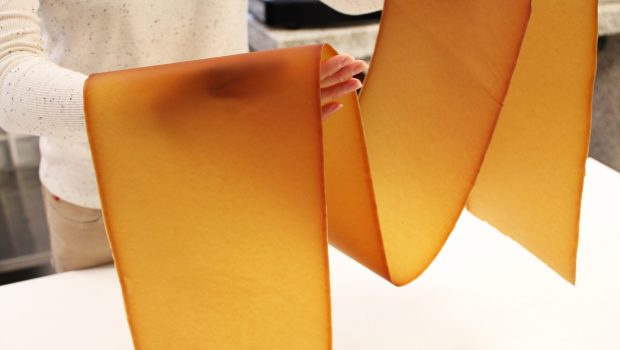New Technology Makes Continuous Sheets of Mushroom Leather
Humans have practiced leather making for over 7,000 years. Today, leather remains one of the most durable and versatile materials. However, an increasing number of consumers are beginning to avoid wearing products sourced from animals due to ethical concerns and the fact that it’s environmentally unsustainable.
The environmental consequences of current processing techniques have led manufacturers to create greener alternatives. Among them are scientists at VTT Technical Research Center in Finland, who have produced an alternative leather made from fungi. What’s more, they’ve demonstrated a new way to create continuous sheets of eco-friendly material at commercial scales.

Conventional leather production has a substantial environmental burden, with a carbon footprint of approximately 130 million tons annually. In addition, it involves vast amounts of land, water, and energy due to mass livestock farming, and processing the leather also has an impact, requiring significant amounts of toxic chemicals.
While so-called “vegan leather,” made from synthetic materials, avoids the issues around animal products, they require toxic chemicals to process and take a long time to biodegrade. It, therefore, causes the same problems as any synthetic plastic.

Thankfully, the leather market has begun looking towards more sustainable, plastic-free, and vegan alternatives that avoid these problems entirely. Last year, two Canadian sisters produced vegan leather items out of apple peel waste collected from the juicing industry. Two Mexican friends made vegan leather from prickly pear cactus; now, mycelium’s latest alternatives are made.
The VTT team’s approach starts with threaded webs of mycelium, an organic material that sprawls out beneath the ground and supports mushrooms as they grow. Using this biomass to produce fabrics and textiles is something that has been done for a long time. However, the VTT scientists have refined these processes to create a skin-like material with similar texture and strength to actual leather.

Géza Szilvay, VTT Senior Scientist, said:
The material has a leathery look and feel and can be as strong as animal leather. It also offers the possibility to be colored and patterned, and it does not contain any backing or supporting materials.
In 2019, the scientists first revealed their process, but an issue remained concerning scaling it up for industrial-style production. This was mainly caused by limitations of mycelium cultivation, which could only occur in a two-dimensional form. To remedy the issue, the VTT team developed a new patent-pending technology that relies on liquid fermentation in standard bioreactors to scale the process up to commercial levels.

VTT’s new technology enables the continuous manufacturing of mycelium leather at scale, rolling out sheets of the material at a rate of one meter (3.3 ft) per minute! In addition, the approach can be adapted to industrial roll-to-roll production methods. The team is currently exploring first product applications for the material, such as accessories, footwear, and garments.
Last year, a study examined the history, sustainability, manufacturing process, cost, and material properties of fungus-derived leather alternatives. It found that Fungi-derived leather is an evolving class of ethically and environmentally responsible materials that are increasingly meeting consumer appealing and functional expectations.
https://www.youtube.com/watch?v=vj0-94b-2S0








Gloss